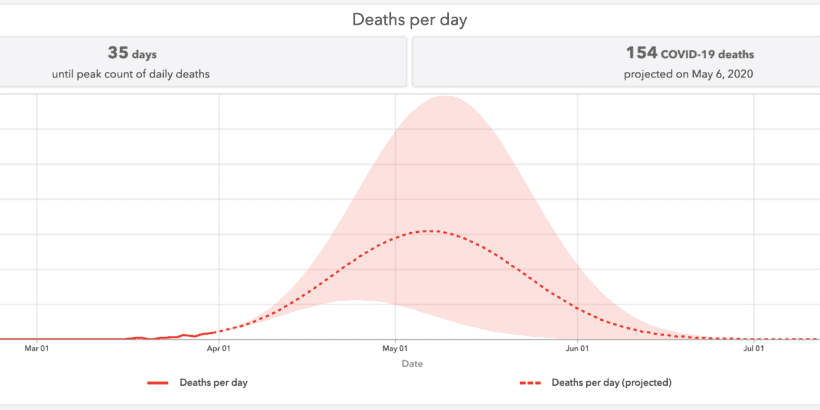5/4/20 Update:
The Institute for Health Metrics and Evaluation (IHME) just updated its latest model and this time the projected death toll has just shot up like crazy. It increased from 74,073 to 134,475 — this is the largest increase that we have seen as you can tell below.
- 5/4/20: 134,475
- 4/27/20: 74,073
- 4/22/20: 65,976
- 4/17/20: 60,308
- 4/13/20: 68,841
- 4/10/20: 61,545
- 4/8/20: 60,415
- 4/6/20: 81,766
- 4/1/20: 93,531

According to CNN, the increase is a direct response from states loosening up on social distancing and re-opening of the economy.
We are truly at the most difficult point in the pandemic as far as decisions go.
Do you keep the lockdowns going and thus take almost total control over the transmission of the disease until it gets close to zero but in the process keep people from working?
Or do you accept a certain number of casualties in the process of gradually re-opening up the economy so that unemployment can go back down and people have income to survive?
It’s a very difficult decision and there really is no best choice other than trying to measure the data and make educated guesses about which route will cause the least amount of damage.
I just hope that whatever decision is made does not result in a large surge of cases that threatens the healthcare system.
Hopefully, some middle ground can be found where establishments begin opening up but people are able to take precautions to mitigate the future spread of the virus until we see a vaccine.
=====
4/27/20 Update:
The Institute for Health Metrics and Evaluation (IHME) just updated its latest model and this time the projected death toll has increased by almost 10,000 from last time. It increased from 65,976 to 74,073 — this is the largest increase that we have seen from this model this month.
- 4/27/20: 74,073
- 4/22/20: 65,976
- 4/17/20: 60,308
- 4/13/20: 68,841
- 4/10/20: 61,545
- 4/8/20: 60,415
- 4/6/20: 81,766
- 4/1/20: 93,531
This increase is not a huge surprise given how the death rate has continued to rise although it has greatly slowed down and we are already on the downside of the peak.
I think that is the most reassuring picture to focus on — the fact that we can see clear downward trend as a nation is huge.
We still have a ways to go but we are not far from having the deaths per day under control at a very low rate. It looks like that could start to happen sometime in the middle of May.

States are now starting to open things back up and so I think that there will be some spikes that occur in the next few weeks (that hopefully get put out pretty quickly). But based on this model, May will be the month of the start of reopening places for lots of states, likely on a staggered basis.
If these models hold true, by the time June starts, we should see a lot of states with reduced lockdowns, although many will likely drag on through at least June.
If you would like to view the models for your state, the country, or for different international locations here is the link to view the models.
======
4/22/20 Update:
The Institute for Health Metrics and Evaluation (IHME) just updated its latest model and this time the projected death toll has increased from last time. It increased from 60,308 to 65,976.
Based on the way the numbers have fluctuated over the past couple of weeks, it looks like the total death toll through August will be somewhere in the 60,000s.
Here’s a look at how the projections have changed:
- 4/22/20: 65,976
- 4/17/20: 60,308
- 4/13/20: 68,841
- 4/10/20: 61,545
- 4/8/20: 60,415
- 4/6/20: 81,766
- 4/1/20: 93,531
So we are still almost 30,000 deaths under the original projection back at the beginning of April.
One trend that is pretty clearly emerging is that we have passed the peak as a country. I guess it’s possible for a spike to come out of nowhere but the graph looks like we are on a pretty clear downward trend at this point.
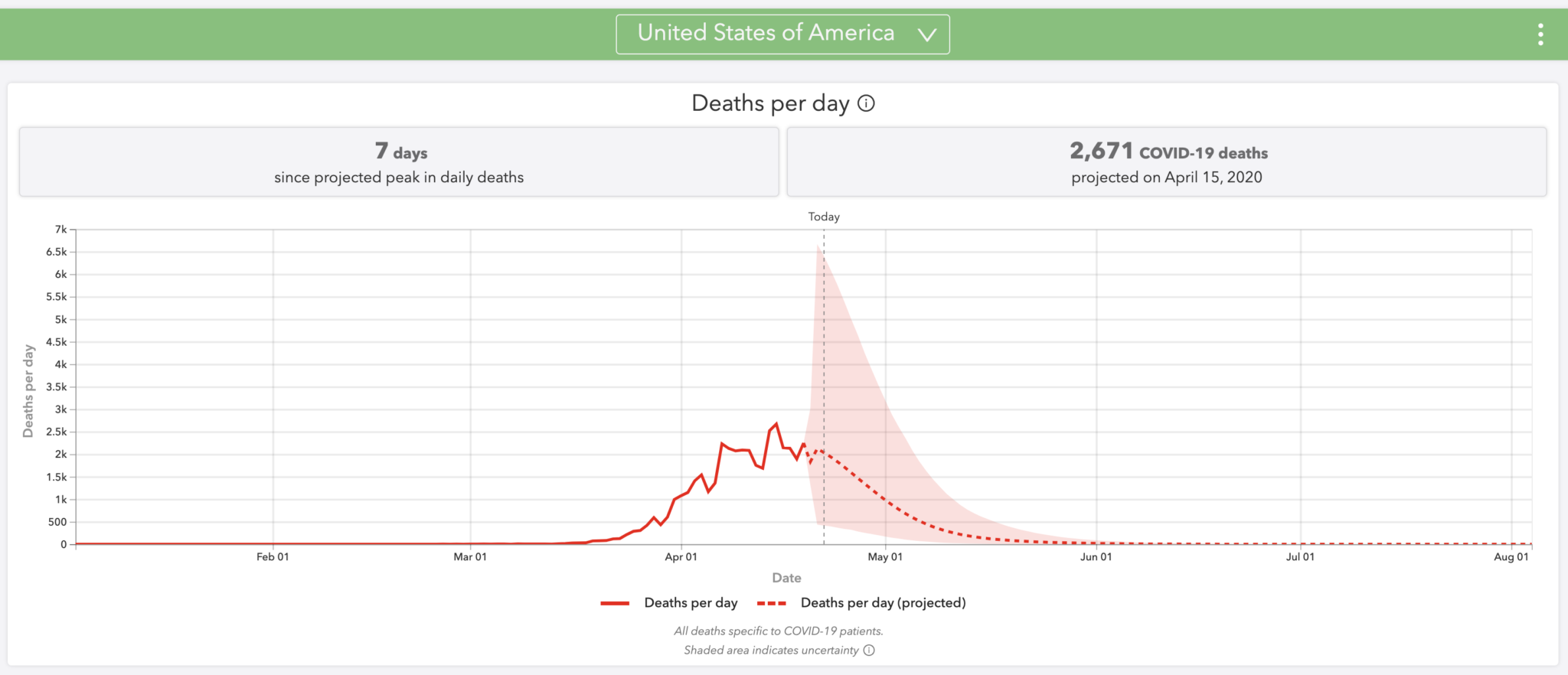
Some states like Georgia are talking about opening up right now and these models assume social distancing through the month of May. So if we start opening up too quickly, it’s possible that these projections could rise and perhaps rise dramatically.
Interestingly, the containment strategies (when it becomes possible to relax social distancing due to testing, contact tracing, isolation, and limiting gathering size) look like they have been pushed out towards the end of June for some states like Arizona. Meanwhile, other states like California have containment periods that could begin in the middle of May.
Recall that the White House announced different phases they will be using to re-open the country. Regions must meet certain requirements like a “downward trajectory of documented cases within a 14 day period” and a “downward trajectory of positive tests as a percent of total tests within a 14-day period” to begin phase one.
If you would like to view the models for your state, the country, or for different international locations here is the link to view the models.
=====
4/17/20 Update:
The Institute for Health Metrics and Evaluation (IHME) just updated its latest model and this time the projected death toll has decreased from last time. It decreased from 68,841 to 60,308.

According to the model, we reached the peak two days ago as a country. But some states have still yet to peak. For example, Texas is projected to peak in two days.
The decrease is very encouraging because the last two updates to the model had the projected that increasing by a good amount. This number will still change based on future data but if this trend continues we might be able to see it dip below 60,000 which will be very encouraging (although still a staggering figure).
Something new that the model is showing now is a “containment period” that would begin June 1.

This means that social distancing could be relaxed at that point subject to certain conditions. For example, containment strategies will need to be in place like:
- Testing
- Contact tracing
- Isolation
- Limiting gathering size
According to IHME, containment could begin when the estimate of when COVID-19 infections drop below 1 per 1 million people in a given location, and its also influenced by each location’s available public health funding to implement new containment strategies.
These new projections come right after the White House just announced different phases they will be using to re-open the country. Regions must meet certain requirements like a “downward trajectory of documented cases within a 14 day period” and a “downward trajectory of positive tests as a percent of total tests within a 14-day period” to begin phase one.
So these models could be used to help approximate when certain states could enter the first phase of opening things back up.
If you would like to do the models for your state, the country, or for different international locations here is the link to view the models.
=====
4/13/20 Update:
The Institute for Health Metrics and Evaluation (IHME) just updated its latest model but this time the projected death toll has increased by a much wider margin than last time. It increased from 61,545 to 68,841.
I was hoping that the death projections would be going down steadily but it looks like they are now going back up, unfortunately. While 68,000 is still a staggering figure, at least it is not in the ballpark of what some other early projections were showing with deaths in the range of several hundred thousand.
It looks like we as a country are still in the midst of the peak although probably very close to things starting to decline. Take a look at the USA graph projections.
It looks like it won’t be until the beginning of June until we see things truly die down to less significant levels. But some states might reach that point at the end of this month.
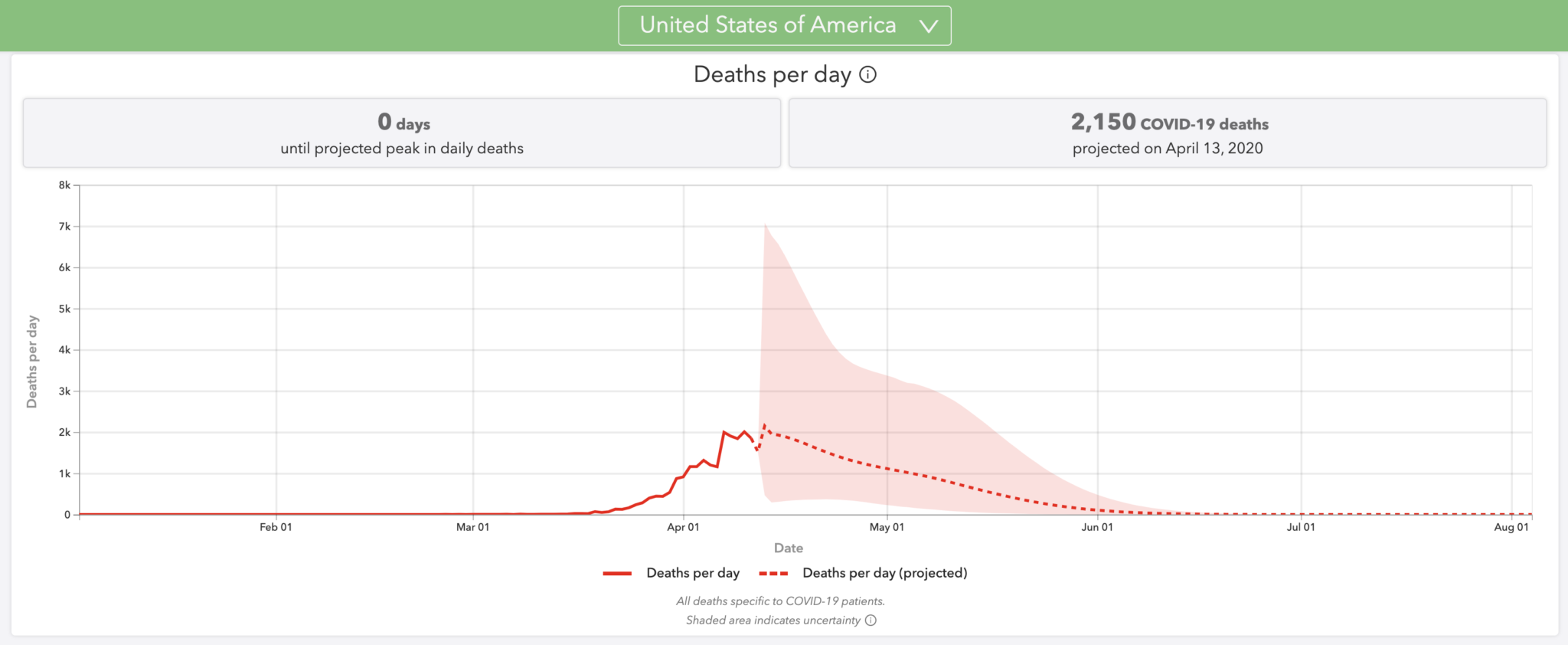
New York looks like it is officially in an early state of decline and that things could be greatly under control by the end of this month.

It is also interesting to look at graphs for countries like Italy where they are clearly in a state of decline.
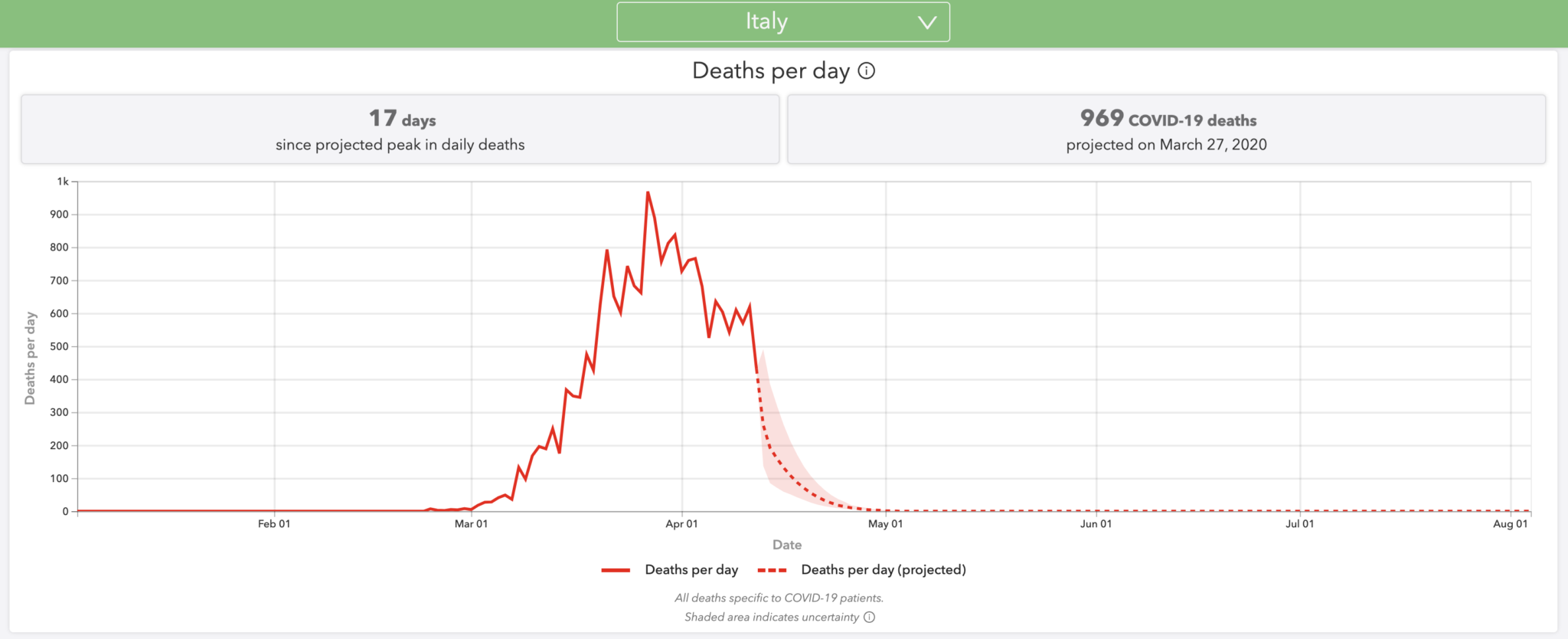
Remember, these models assume social distancing all the way through May so if our leaders change policies too quickly on social distancing we could see things drag out further.
If you would like to do the models for your state, the country, or for different international locations here is the link to view the models.
=====
4/10/20 Update:
The Institute for Health Metrics and Evaluation (IHME) just updated its latest model but this time the projected death toll has increased.
It is only a slight increase of 60,415 to 61,545.
This is not completely unexpected given how they update the model with new data. I still think that it will eventually go down. Basically new data is coming in from states as they get hit with their first major waves of the virus in so I believe that is causing the slight uptick. This is just my speculation, but I believe once those states get things under control, these numbers may start to go down again.
Something interesting is that today is scheduled to be the peak for deaths. So if this model is correct, then things should start going downhill after today which is really great news.
So, it looks like the peak has been pushed out for certain states like Texas but only by a few days.
I try not to put too much stock into these projections because they are subject to change but I still feel like the trends are much more positive than we initially imagined, especially in terms of the worst case scenario.
If you would like to do the models for your state, the country, or for different international locations here is the link to view the models.

====
4/8/20 Update:
The Institute for Health Metrics and Evaluation (IHME) just updated its latest model and it once again shows a decreased projected total death count.
This time the decreased death count has been more significant.
We recently saw the number of projected deaths drop from 93,531 to 81,766. But now the new model is showing an expected total number of deaths at 60,415.
Once again, this is still an outrageously high number but it is consistently dropping as they input new data. I’ve got a feeling that this number is going to continue to drop over the next few days and weeks and may eventually resemble something closer to the annual death toll of the flu.
So this model has me feeling extremely optimistic in terms of the trends we are seeing, and I think it is proof that social distancing is having a great impact on the spread of the disease.
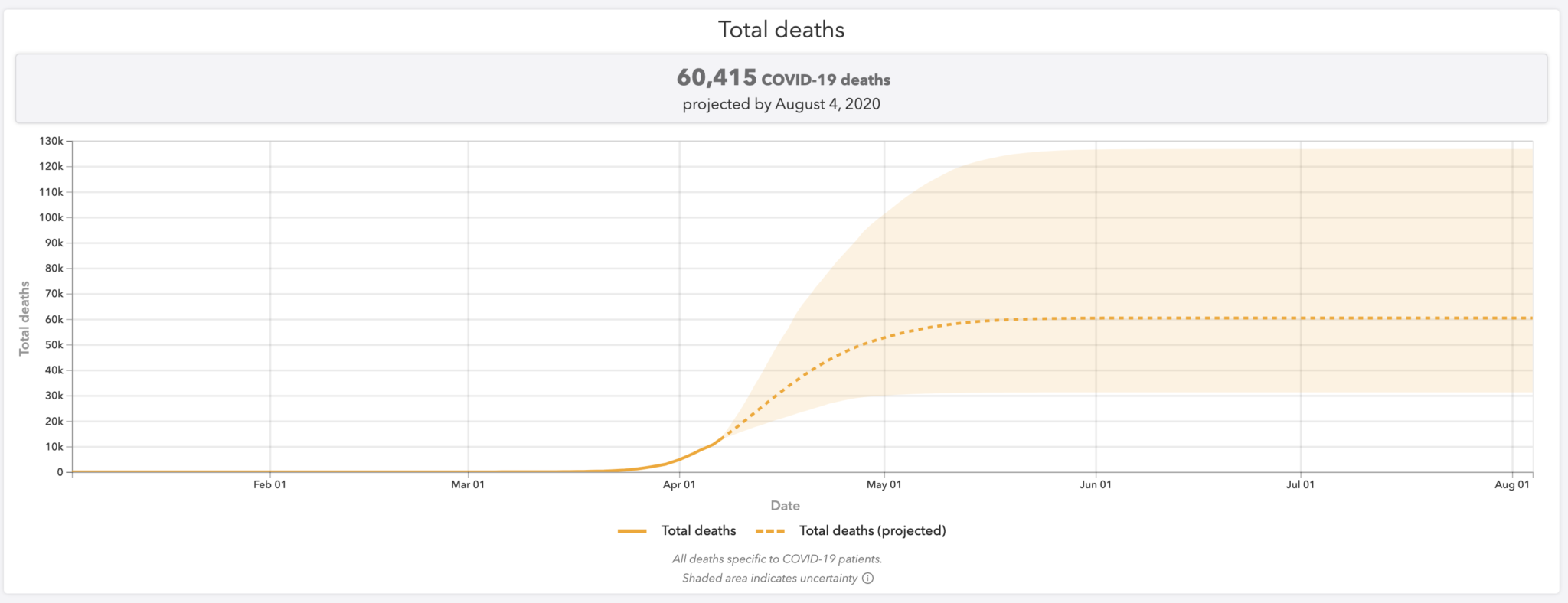
Something else that is new about the model is that you can now view data from different countries so it is interesting to see a few countries like Italy where you can see a clear downward trend going on now. If you would like to search for different countries or for your specific state, scroll down and you’ll see the link to find the charts.

4/6/20 Update:
The Institute for Health Metrics and Evaluation just released its latest model and it shows a decreased projected total death count. The total number of projected deaths in the last model was 93,531 through August but this has just been decreased to 81,766.
I want to reiterate that these are just projections and that they will be continuously changing as new data points are input but this is highly encouraging.
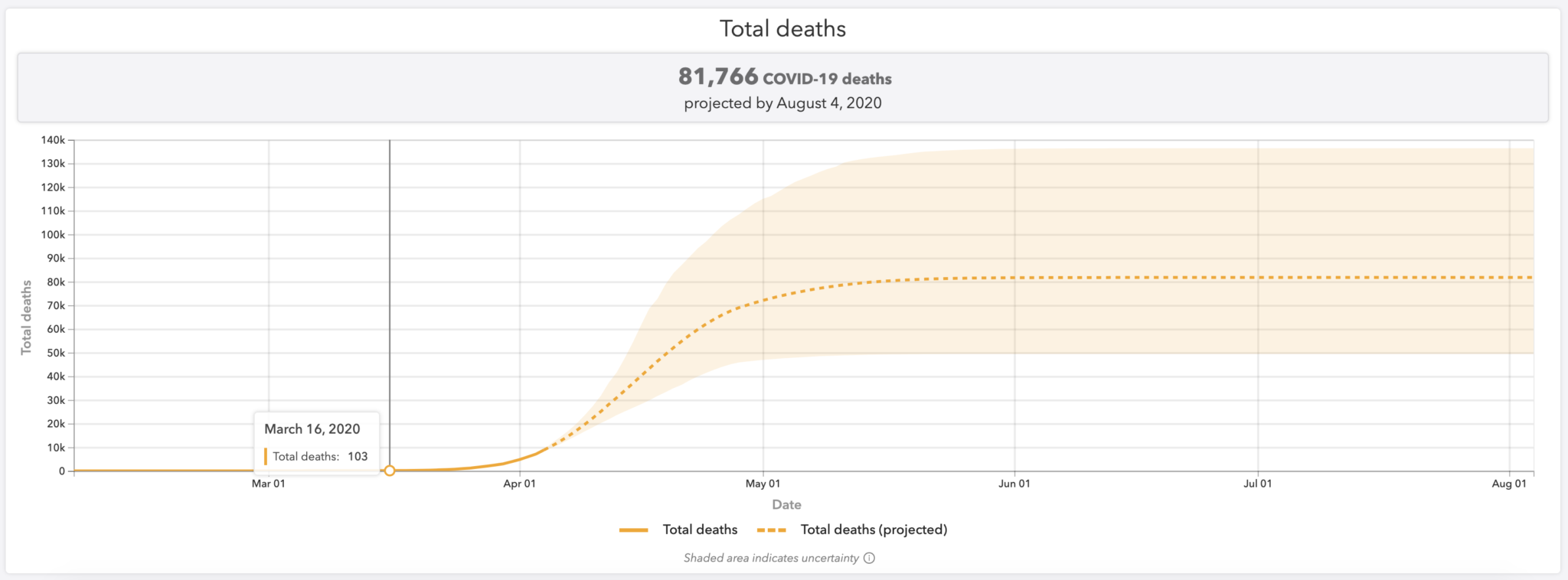
The other exciting development here is that the peak of infection looks like it has been pushed forward in some states. For example, in Texas the peak looks like it is about April 20th. But in prior models it was showing the first week of May.
If this trend holds true then this means that we will be hitting the peak sooner and therefore we should be able to lift lockdowns sooner as well.
Now, I am not a medical professional or statistician but I do know how to read graphs and seeing these trends change looks like a very positive change.
There are about 10,000 fewer deaths predicted and the peaks look flatter and like they are arriving sooner so I think those are all three very positive signals.
I would encourage you to check the link below to see when the peak is expected to happen in your state.
========
4/1/20 Original article:
The Institute for Health Metrics and Evaluation is an independent research center at the University of Washington and they developed a model projecting coronavirus growth across the US.
These models break down the expected peaks of coronavirus for each state and also for the entire country over the next few months. These models are just predictions so they may not be accurate in all cases and will likely need to be updated as more data comes in over the next couple of weeks.
However, these models can still be helpful to people who are trying to figure out what to expect to happen to the country over the next few months and also how their state compares to others.
They will also be helpful for travelers who are trying to time when things may begin to calm down in their region or to another region that they plan on traveling to.
These models assume that social distancing is continued through the months of April and May.
For those of you who think that social distancing will end at the current 30 day period recommended by the White House, I think you will be disappointed as I fully expect that extension to go all the way through May. Maybe it won’t but that would be surprising to me.
Link to view models
Anyway, here is the link to view the models.
You will be able to select the country or the individual state that you would like to look into. It also has projections for medical needs, such as hospital beds, but if you scroll down you will see the projections for total deaths.
Here’s the model for the US:
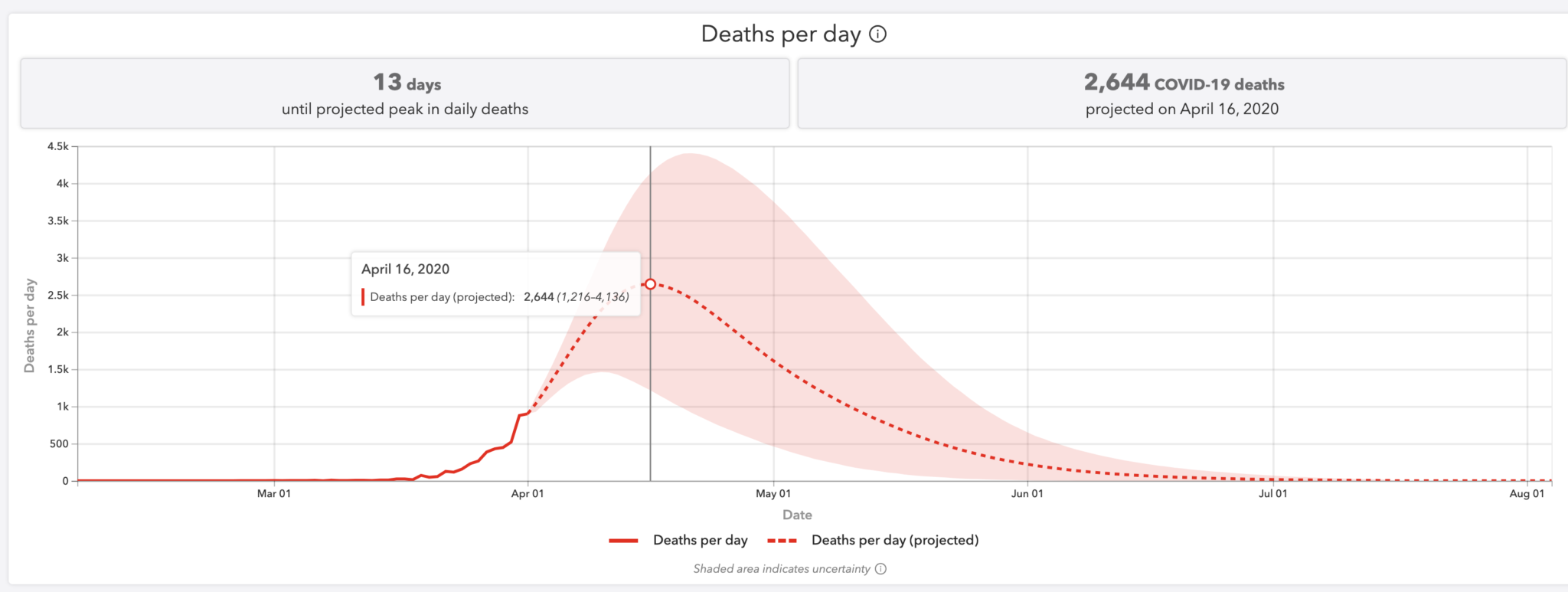
Here’s the model for Texas:
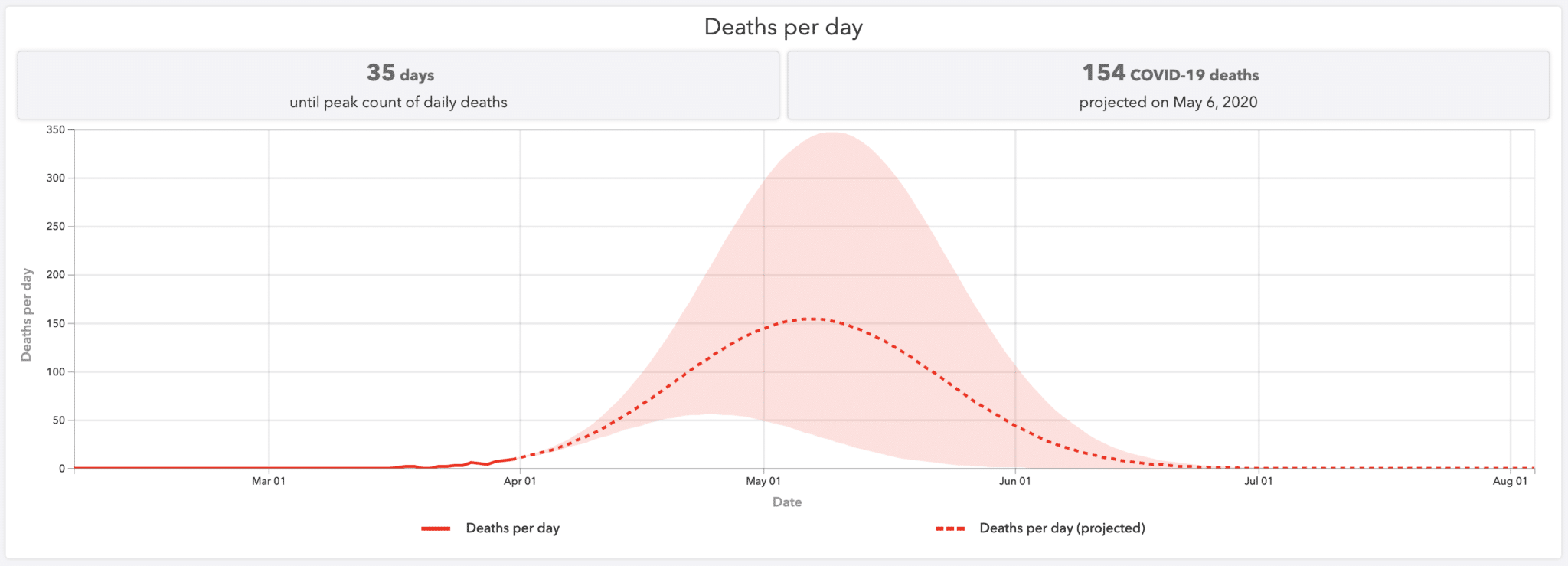
It’s possible that we will not see as many deaths that are predicted but at this point I don’t think anybody really knows or can predict with certainty what will happen.
We really need to see how much of an impact of social distancing is going to have, and I think that is still going to take another couple of weeks for us to get a true grasp on based on what experts have been saying.
I will continue to monitor these graphs and update this article as the dates begin to change.
Daniel Gillaspia is the Founder of UponArriving.com and the credit card app, WalletFlo. He is a former attorney turned travel expert covering destinations along with TSA, airline, and hotel policies. Since 2014, his content has been featured in publications such as National Geographic, Smithsonian Magazine, and CNBC. Read my bio.

